
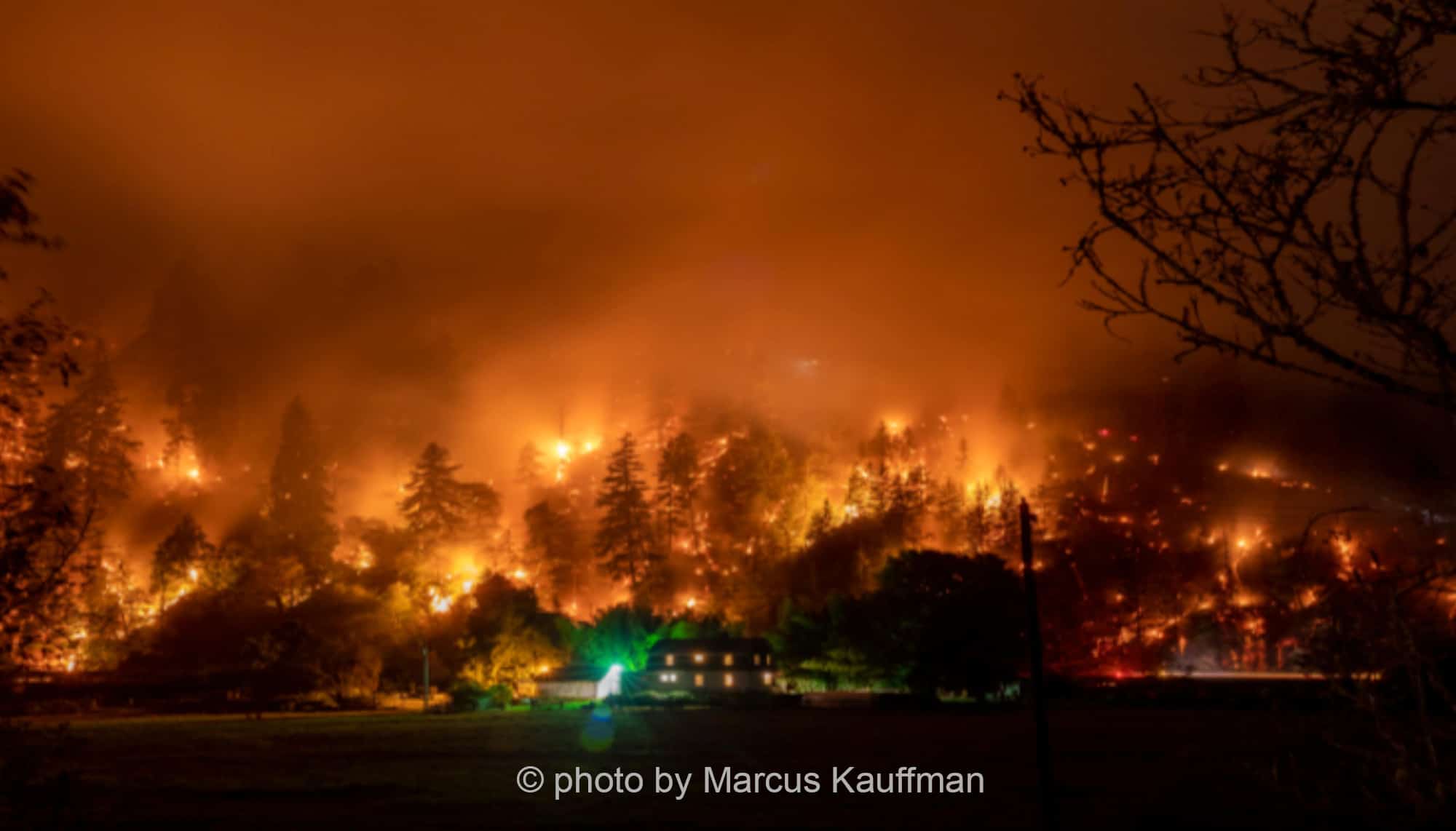
Sweet Creek Milepost 2 Fire, Oregon Department of Forestry
Wildfire Preparedness for Home Landscapes
Take these steps to reduce the risk of home loss in the case of wildfire.
Subscribe to the Blog >By Marlene Finley

Marlene Finley, Skagit County WSU Extension Master Gardener
The recent wildfires in Hawaii make it clear again that few locales are immune from the devastating effects caused by wildfire. Despite Western Washington’s wet reputation, we also are not immune to wildfires, especially during drier years. Here in Skagit County, we also are facing moderate drought. (See https://www.drought.gov/states/Washington )
A recent climate impact study developed by the University of Washington’s Climate Impacts Group, reported that the temperature in Washington has increased 1.5° F over the last 20 years. This climate summary makes three dire predictions. First, historically unprecedented warming is projected throughout the century. Second, warming temperatures will lead to earlier melting of mountain snowpacks which are critical for spring and summer water supplies. In addition, more precipitation will be in the form of rain instead of snow, which could lead to flooding. Last, wildfires are predicted to occur more frequently and with greater severity during dry summer months. Warming temperatures are expected to cause additional forest mortality and long-term transformation of forested landscapes across the Northwest by increasing wildfire, insect outbreaks, tree diseases, and drought stress. (Source: University of Washington Climate Impacts Group)
As gardeners, we are keen observers, taking notice of the slightest changes in our gardens and surrounding natural areas.
We tend to be a curious lot and as a result, tend to be good problem solvers. Considering the trends and predictions, there are plant choices and gardening practices that will help keep our treasured landscapes resilient and thriving under the threat of wildfire and a changing climate.
Firewise landscaping is an array of practices promoted by the National Fire Protection Association (NPFA) and others to create a defensible space around your home that can slow a wildfire or discourage ignition. Vents, eaves, and gutters should be free of leaves or other debris, areas under decks should be clear of flammables, and plants growing near a home should be fire-wise, meaning a low probability of catching fire. Trees overhanging roofs can be problematic in the event of wildfire.
These are a few practices you can take to be prepared this fire season:
First, remove fire fuel wherever possible.
Clean your gutters of debris and make sure your roof is clear of leaves and moss. Many of the large, catastrophic fires in the West in recent years were fueled by warm, dry, and in many cases extreme wind, blowing hot embers as much as a mile in advance of the fireline. These embers catch fire in dry leaves in gutters and unscreened attic vents, eaves, and soffits. Install 1/8 inch metal mesh screening to block embers.
Never store flammable materials underneath elevated decks or porches (for example firewood) and clean dead vegetation from between deck boards and under the deck. Visit Firewise.org for more information. Skagit Conservation District schedules free, customized homeowner assistance on reducing the threat of wildfire, as well as providing helpful information specific to our area on their website.
Second, plant for moisture resilience.
Healthy plants tend to be more resilient to swings in temperature and moisture. Choosing plants to fit the specific conditions in your garden, considering soil, moisture, sun exposure, and otherwise gardening factors will help create a resilient garden.
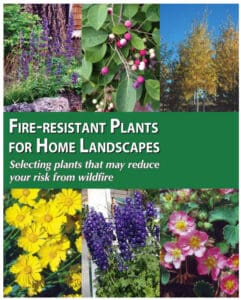 Get the List and Let’s Talk Plants!
Get the List and Let’s Talk Plants!
An excellent publication produced by Washington State University, Oregon State University, and the University of Idaho titled Fire Resistant Plants for the Home Landscapes. This free pdf download includes an extensive list of plants that tend to be less flammable. See the resources below.
Plants that include these characteristics are, in general, good choices for fire-wise gardens:
1. Higher moisture content in their leaves
2. Little build-up of dead vegetation
3. Resistance to drought
4. Low, compact growth form
5. Leaves that will not catch and hold embers
Consider groupings of plants and introduce more diversity of species or varieties to assure more vitality. A well-designed plant community tends to be more drought-tolerant and insulating to extreme changes. Native plants often make good choices. Both Skagit Conservation District and the Salal Chapter of the Washington Native Plant Society hold regular native plant sales and can advise you of good choices for resilient, fire-wise plants for your particular needs. During the Master Gardener plant sale in May, you’ll find recommended groupings of plants that grow well together, both aesthetically and ecologically.
In addition to choosing the right plant for the right place, watering plants during extended dry spells is critical. Even drought-resistant plants need water, especially in the first year or two after planting as roots become established. Drip irrigation systems that deliver just the right amount of water at the correct intervals help conserve water during dry months. See our recent blog post on DIY Drip Irrigation > https://www.skagitmg.org/diy-drip-irrigation/
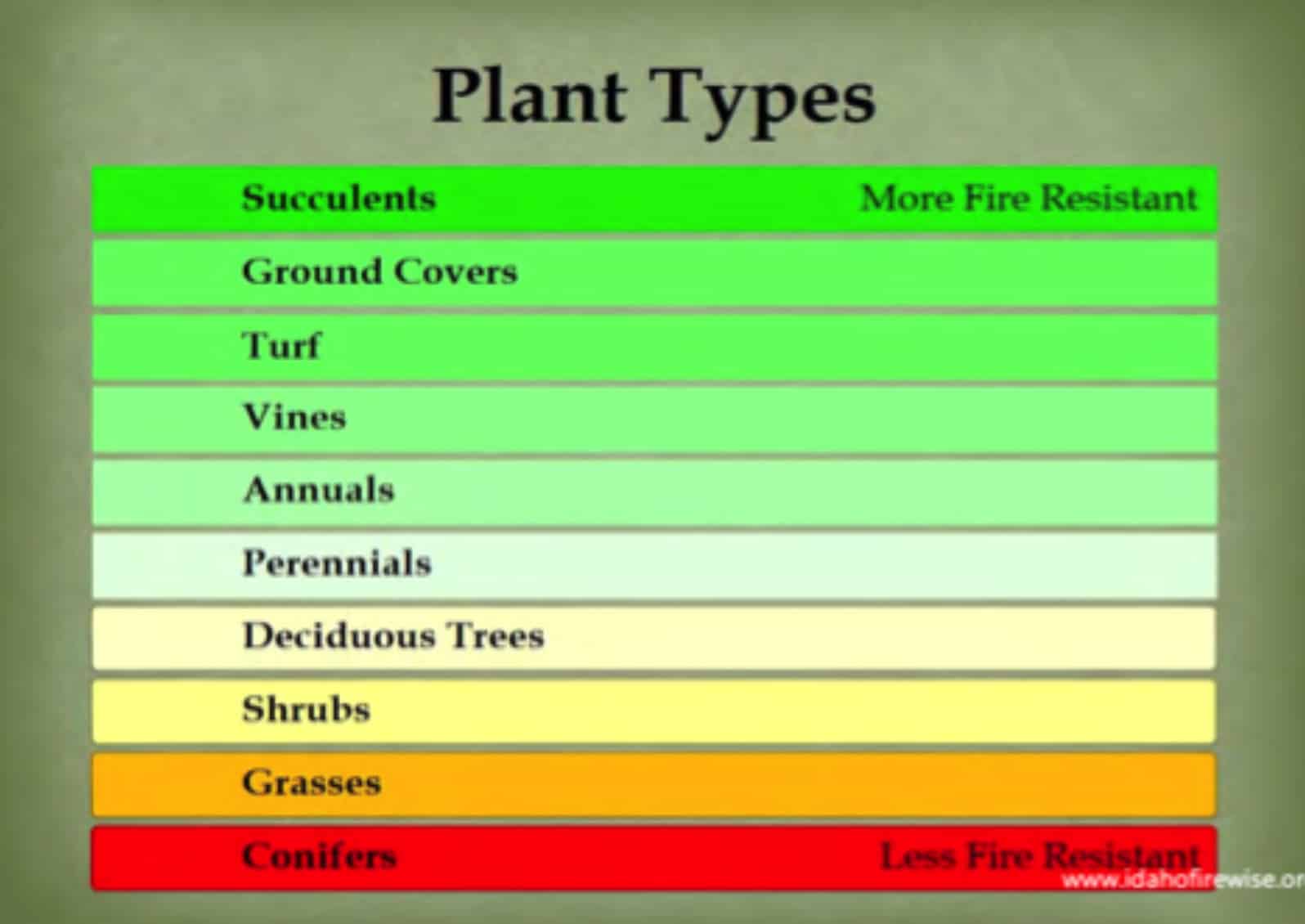
Consider groupings of plants and introduce more diversity of species or varieties to assure more vitality. Photo courtesy of Marlene Finley
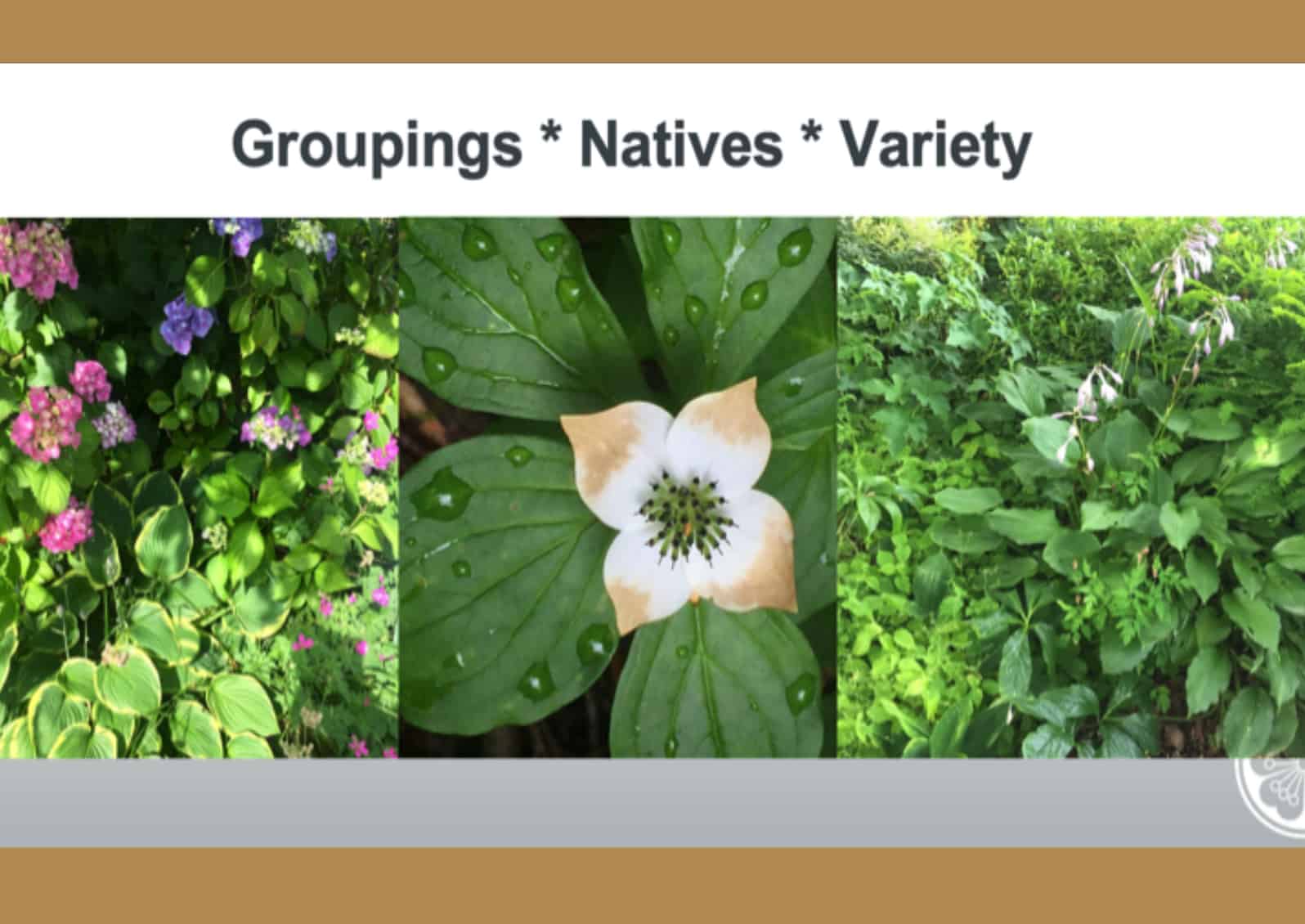
Native plants can provide aesthetic beauty as well as fire resistance. Photo courtesy of Marlene Finley
Third, create a defensible space.
Fire professionals often talk about maintaining a defensible space within 100 to 200 feet of your home. Within this area modify the landscaping to give your house the best chance to survive on its own. This will greatly improve the odds of success for firefighters who are defending your neighborhood. If your home is on a slope or subject to high winds, extend the area of this zone to whatever your fire department recommends. Separate shrubs (with spaces of at least 10 feet between clumps), limb up trees, and use hardscaping such as rock, stone pathways, and concrete to break up potential fire fuels.
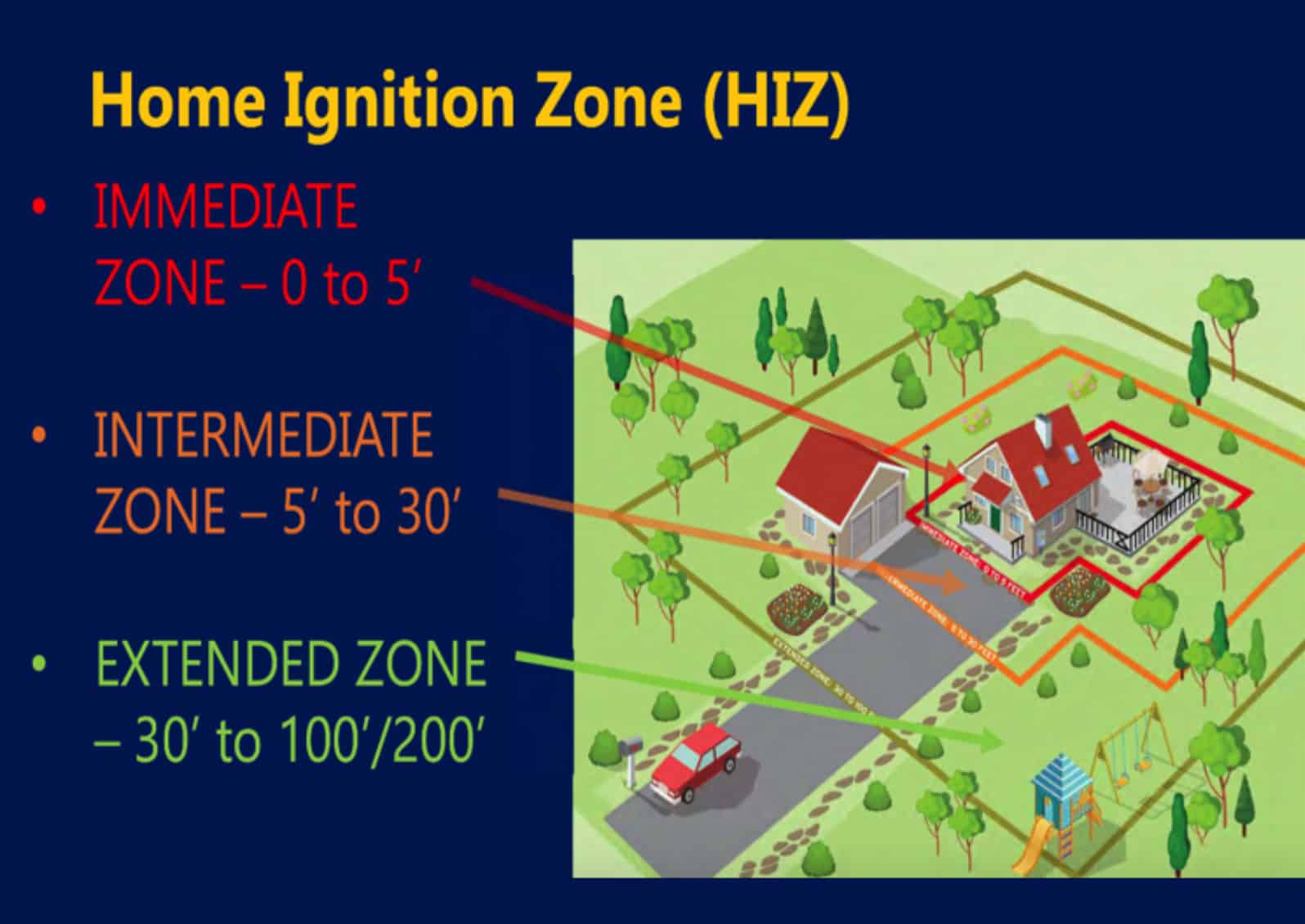
Nearest to the home: hardscape, low growing, wet loving plants. Anything flammable (deck, connected wooden fence) will carry fire to the home structure. Illustration courtesy of Skagit Conservation District
Within 5 to 30 feet of the home use only individual trees or shrubs, keeping them well maintained and pruned up. Remove dead, dry leaves, needles, or branches, and do not place flammable mulch near the foundation.
Beyond using inflammable hardscape, groundcovers such as succulents and even a narrow band of turf grass can provide valuable protection. Keep grass near your home (both turf and natural meadows) watered, if possible, and mowed during fire season to no more than 4 inches. Check the list of fire-resistant recommended plants in the publication cited above for the best choices of plants and grass to grow from 0 to 30 feet from your foundation.
Pruning plants to reduce dead and dying limbs and leaves is critical. While no plants are completely fire resistant, chances of surviving and slowing the spread of fire are better when there is less flammable material on the ground and within plants and trees. You may wonder “Why remove dead leaves when we know they create habitat for beneficial insects and wildlife?” Removing flammables during fire season, within the ignition zone of your home will increase your chances for survival and keeping your home.
Removing ladder fuels (vegetation under trees) prevents fires from reaching the crowns of trees. Prune trees at least 6 to 10 feet from the ground; for shorter trees, do not trim more than 1/3 of the overall tree height. Trees overhanging roofs and structures can be problematic and should be trimmed back, in fact, there should be no trees and or shrubs within the first 0-5 feet of the foundation and few scattered trees or shrubs within 5 feet to 30 feet of the structure.
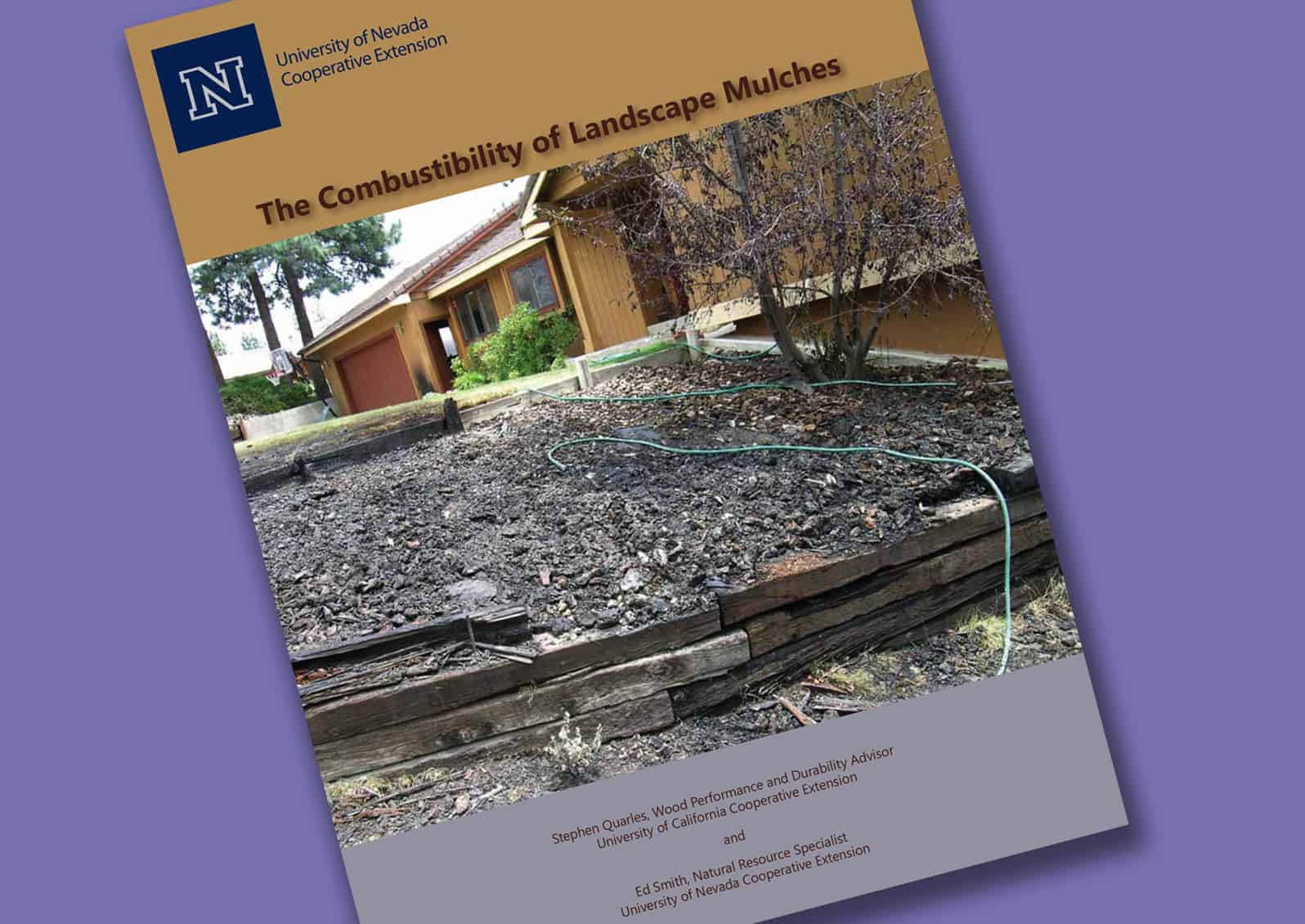
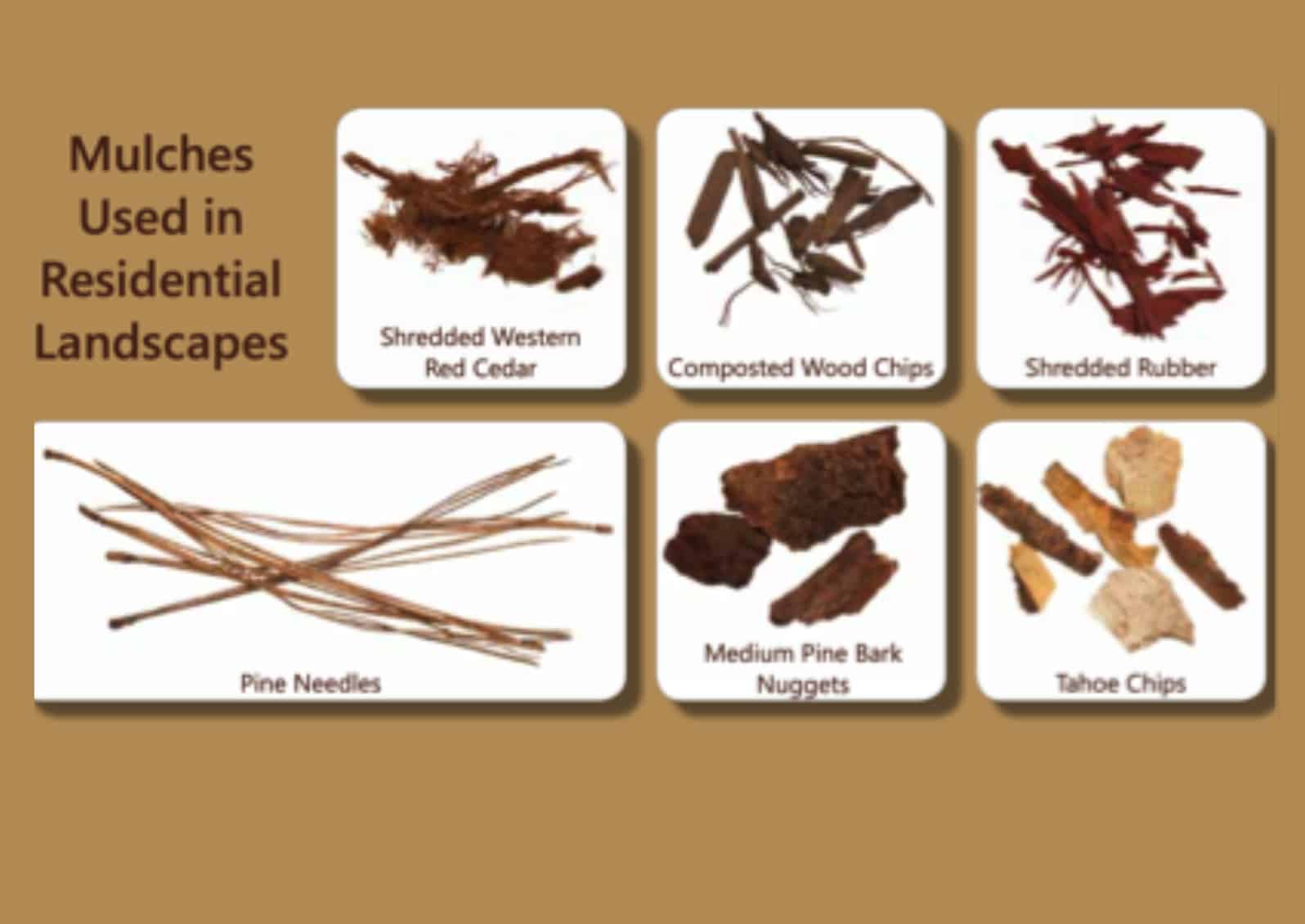
The University of Nevada Cooperative Extension conducted a study on the flammability of certain mulches.
What About Mulch?
Mulch helps to retain soil moisture over the summer and insulate in winter and can be used beyond 5 feet from the foundation. Do not use flammable mulches or groundcovers within 5 feet of your foundation. The University of Nevada Cooperative Extension conducted a study on the flammability of certain mulches.
While the University of Nevada study showed the best results for “composted” wood chips, WSU scientist Dr. Linda Chalker-Scott recommends using fresh arborist chips because valuable nutrients are lost during composting. https://gardenprofessors.com/making-your-landscape-fire-resistant-during-wildfire-season/
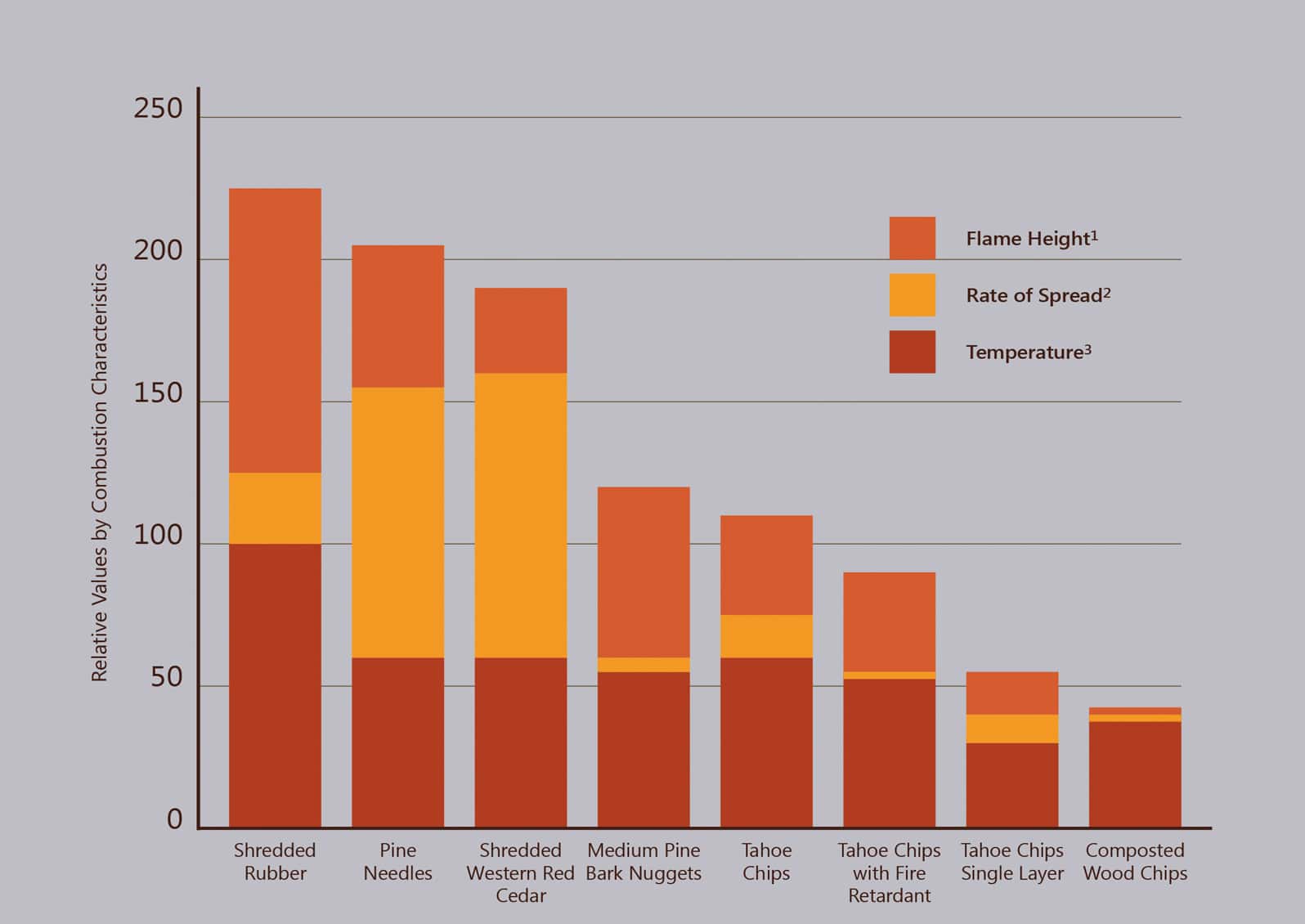
While the University of Nevada study showed the best results for “composted” wood chips, WSU scientist, Dr. Linda Chalker-Scott, recommends using fresh arborist chips because valuable nutrients are lost during composting. (Source: Making Your Landscape Fire Resistant During Wildfire Season, The Garden Professors 2009)
Key Take-Aways:
- Maintenance – clean gutters and roof, no flammables against house or under deck
- Prune out deadwood and debris, clean up pine needles, leaves, twigs
- Landscape according to Fire Ignition Zones: 5 feet, 30 feet, 100 feet
- Maintain defensible space and create fuel breaks
- No plants are completely fire-resistant. Healthy plants are fire safe
- Keep moisture in the soil during hot, dry spells with drip irrigation, permeable surfaces, groundcovers, compost, and mulch
The devastating effects of our warming climate are in the news daily. The large Canadian fires early in the season captured our attention. Following the recommendations regarding plants and garden practices can slow the effects of the changing climate as well as provide thriving, functioning landscapes that will persist through the immediate changes while slowing the spread of wildfire.
RESOURCES:
Curious and conscientious caretakers of backyards and natural areas can learn more at these various resources:
- Chalker-Scott, Linda. The Myth of Pretty Mulch in Horticultural Myths. Washington State University Extension. https://s3.wp.wsu.edu/uploads/sites/403/2015/03/bark-mulch.pdf
- Drought Conditions by state and county (new website from NOAA). https://www.drought.gov/states/Washington
- InciWeb provides up-to-date information on wildfires throughout the country. Research fire status in your area and check travel routes and destinations. https://inciweb.wildfire.gov/accessible-view
- Firewise: Learn more about reducing wildfire risks. https://www.nfpa.org/Public-Education/Fire-causes-and-risks/Wildfire/Firewise-USA
- Detweiler, Amy. Fitzgerald, Stephen. Fire-Resistant Plants for Home Landscapes. 2006 Oregon State University Extension, PNW 590. https://catalog.extension.oregonstate.edu/sites/catalog/files/project/pdf/pnw590.pdf
- The Garden Professors website is a great resource for gardening including climate wise and fire wise landscaping.
https://gardenprofessors.com/making-your-landscape-fire-resistant-during-wildfire-season/ - Skagit Conservation District. Free, at home consultations on reducing wildfire risk. https://www.skagitcd.org/wild-fire
- University of Washington Climate Impacts Group. https://cig.uw.edu/our-work/forests-fire/
ABOUT THE AUTHOR:
Marlene Finley, is a former wildland firefighter, retired forest manager and currently active Skagit County Master Gardener.
_________
Questions about home gardening or becoming a Master Gardener may be directed to: Skagit County WSU Extension Office, 11768 Westar Lane, Suite A, Burlington, WA 98233; by phone: 360-428-4270; or via the website: www.skagit.wsu.edu/mg